Our Treatment Methods
Engrams the Power of Patterns
"Repetitive stress on the body whether through emotional and physiological insults or physical injury initially evokes a protective response but unless this mechanism is ameliorated it will leave its mark on the body and the psyche; in the former as a variety of syndromes as diverse as Endometriosis and Rotator cuff syndrome and in the latter chronic pain syndromes."
"Recognising a commonality of cause and effect in the body's response is the key to first alleviating further adverse changes and ultimately to undo these changes. The therapies offered here work with the physiological changes not against them essentially telling the body to switch off unneeded responses."
"Last but not least they comply with the dictum 'primum non nocere' first do no harm." ~Dr Paul Crozier.
- The Greek and Roman physicians and Plato and Hippocrates knew disease is actually two words 'dis' and 'ease' or the lack of ease in the body.
- Muscular stress can and does physically stress your organs by restricting their natural operating space and distorting their natural body positions.
- This can increase or decrease organ function and create dis-ease states.
- Successful Holistic health treatments focus on locating the tension or disease patterns throughout the body, releasing them so the 'dis' goes away the 'ease' comes back into a persons life.
- Holistic therapists don't "fix" anybody they facilitate internal communication so patients can fix themselves.
- Ideally to complete the process it's important to locate the 'primary cause' of the patterns formation and if possible bring it to the patients attention.
- This will ensure the patterns don't reappear and patients get well and stay 'disease' free.
 Our Engrams Start Early in Life
Our Engrams Start Early in Life
From the age of 6½ weeks the human foetus can feel. They begin to develop patterns of behaviour based on what they can feel in their environment. These patterns are called "engrams".
Standing up for yourself!
Standing up involves a complex sequence of learned muscle activity. Get it wrong it's embarrassing. Learning how to do it right can be liberating.

- It requires vastly complex thought patterns to tell each muscle when to work in order to complete our daily tasks.
- To make it easier we develop and play 'engrams' or muscle patterns and our bodies follow the patterns.
- Most importantly we also use engrams to avoid things we don't like such as pain.
- As a child we put pain and fear together, pain = fear = run away, which as a small creature is a good idea for keeping the little creature alive. An instant muscle pattern response, can literally mean the difference between life and death.
- For a child engrams can make life so much easier as we learn to survive and get comfortable in our own skin, however left unchecked they can become entrenched and if left unnoticed, as an adult they can be crippling as our Golgi Tendon organ reflexes and the engrams they create can literally take over our lives.

- Engrams develop as the foetus moves around in the womb. Over time it builds huge files of data on what it likes and doesn't like and the thing it doesn't like the most is pain so it moves to be comfortable.
- The most commonly recognised 'engram' is a smile. When we smile 17 muscles form into a pattern and 'ka ching' a smile is formed.
- A frown or a fake smile takes more muscles!
Golgi Tendon Organs & Engrams
If you've ever seen an arm wrestle and one contestants arm
just gives up, that happened through the action of a muscle safety switch called a Golgi tendon organ reflex. If we do get injured this can set up a pain engram to avoid disturbing that
injury.
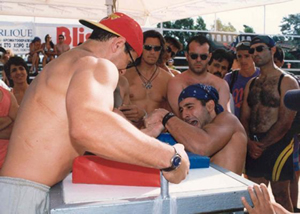
- If engrams get too much control as an adult we can end up hunched over and limping around trying not to disturb things that really started out as minor issues in childhood. Patterns and sequences of pain that are now crippling us as an adult!
- These patterns have been described for thousands of years and with focus and study they can be deciphered and then released.
- The indicators for treatment are often there in modern language. Sayings like "someone is a pain in the ass", "he/she makes me sick to my stomach", or "they are a pain in the neck" all have foundations in our internal talk.
- Understanding how, where, and why we hurt can describe a large range of emotional issues. Even how we stand can be a direct indicator to our emotional state.
Following the Law!
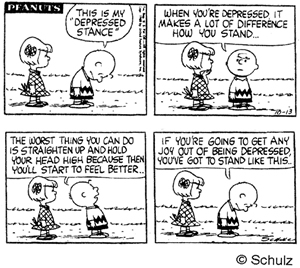
- Facilitation law states that when an impulse has passed through a certain set of neurons to the exclusion of others, it will tend to take the same course on a future occasion, and each time it traverses this path, the resistance will be less.
- This causes the body to produce habitual patterns when a neural pathway is activated and can eventually result in chronic patterns that may well seem insurmountable.
- By following the Law of Facilitation, the nervous system conditions itself to find the path of least resistance building patterns of easy flow and muscle use often to the detriment of the individual involved
- This is why old injuries tend to get re-aggravated with less stimulus, and pain patterns tend to become set patterns in the body.
- These pain patterns can also come from 'nice' even 'happy' overuse patterns such as playing music or dancing, horse riding, cuddling a baby or a pet, in fact any favoured repetitive activity.
- Facilitation is why engrams can establish strong patterns in your posture and why an 81 year old when unconscious on the surgical table is as loose and floppy as an 18 year old on the surgical table. However when they both regain consciousness the 81 year old returns to their 'old age' engram, stooped with age and the 18 year old returns to his partially programmed floppy self.
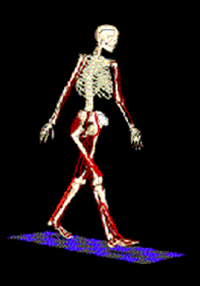 Who's Programming Your Life!
Who's Programming Your Life!
The Golgi tendon reflex is a protective feedback mechanism controlling the tension of an active muscle by inducing relaxation 'before' the tendon tension becomes high enough to cause damage.
Over time very complex movements develop in order to avoid disturbing pain. Normally we don't know just how much they are affecting us.
And most often, it's what you don't know that you don't know, that literally bites you on the ass!
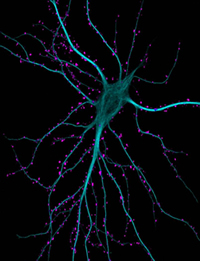 Finding the Patterns
Finding the Patterns
Engrams are also patterns of muscle movement that make it easy for athletes to perform all sorts very complex tasks. Andre Agasi and Venus Williams programmed their sporting engrams from a very early age.
Gymnasts, musicians even race car drivers do the same thing. They program the body to follow a set pattern of muscle firings to achieve a set task.
These patterns form in kinetic pathways all over the body often in seemingly unrelated places by counter balancing bodyweight and required pressures with our limbs and muscles to ensure we can complete our tasks.
The work you are about to see...
The work you are about to see has been developed through observation over many thousands of successful case treatments. These engram identifying methods have been in use in chronic injury and emotional trauma case treatments for nearly two decades.
We have found if you can locate the 'original injury' and release any adhesions and tension at that site, long term dysfunctions can be corrected quite rapidly.
Like all bodywork it is 'not' science and often art you will need to interpret what you find so use your initiative and follow your therapeutic intuition.
We trust you will find it of value and use in developing your own successful assessments and treatments.
We use engrams for all sorts of things, here are a few to consider.
 Communication Engrams
Communication Engrams
When we smile 17 muscles form into a pattern and 'ka ching' a smile is formed. We don't have to consciously think about it the smile engram tells each muscle what it needs to do. Our brain plays the smiley face music and the muscles follow the tune.
 Naming the Pains!
Naming the Pains!
When we say someone is "a pain in the neck", something makes me "sick to my stomach!" or someone is a "pain in the butt" these are vocalisations.
They describe muscular tension patterns that we develop in response to emotional stress.
By decoding these vocalisations and closely observing musculo- skeletal dysfunction patterns, more rapid diagnosis of causal factors and higher levels of patient resolutions can be achieved.
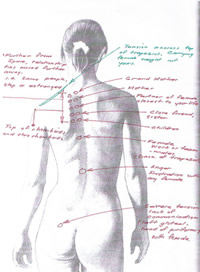 Why the muscles in your jaw can be a pain in the ass!
Why the muscles in your jaw can be a pain in the ass!
Physical tension can't magically flow out from a muscle into the universe. What actually happens is your body distributes the tension along kinetic pathways to help spread the load!
With the jaw, RSI injury tension from one of the strongest muscles in the body, the massetter, is distributed to some of the strongest and largest muscles, the gluteals.
Tension from the jaw travels all the way to the butt, causing a pain in the ass!
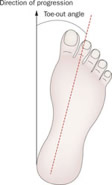 A Tight Masseter = A Sore Butt?
A Tight Masseter = A Sore Butt?
Jaw tension is easily spotted in most people you can see it on their face. Their jaw will be lopsided and short on the left side. If you feel it may be from an emotional cause. Try looking at the way they walk!
If you see someone with a lop-sided jaw and you also find a laterally rotated left leg. You will often find a tight left piriformis, masseter, and psoas! If you do, they may have formed a communication Engram!
Not Communicating with Males
= Sore Right Masseter

Not Communicating with Males
= Sore Right Piriformis and Right Psoas

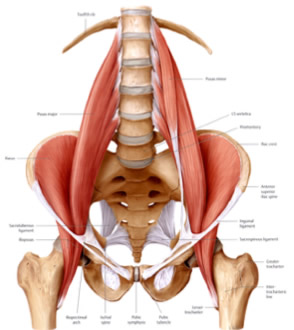 Psoas, a Hidden Problem!
Psoas, a Hidden Problem!
Hidden deep in the body is Psoas the primary muscle in the fight or flight response. It responds to any perceived threat by immediately going into tension.
When it does this it compresses and stimulates the adrenals, releasing and elevating adrenaline and cortisol levels.
This can leave patients in a constant state of anxiety, high muscle tone and inflammation plus low on serotonin.
Whilst Psoas can get injured from excessive load in an incorrect lifting position ultimately causing a laterally rotated gait.
We find it is usually the reverse, the lateral rotation is caused by tension down the Masseter / Piriformis / Psoas pathway.
This lateral rotation can contribute to chronic Tibialis Anterior muscle and knee pain, as well as a contribute to a number of uterine conditions.
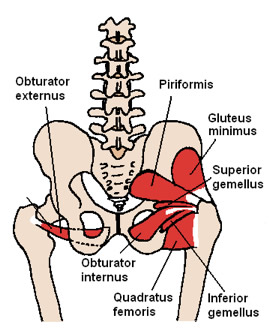
Pain in the butt tension first affects the hips then knees
and ankles.
A Tight Masseter Can Also =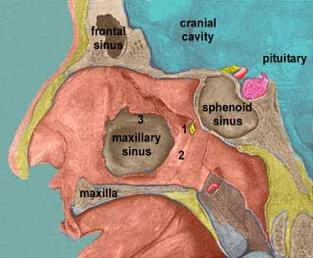
Underneath the Masseter is the maxilla sinus and if the Masseter is in a pain spasm response, the maxilla sinus can easily become blocked, stressed and diseased. Sinusitis may set in and acid levels in the mouth can elevate causing many of the over 400 species of helpful bacteria in the mouth begin to die.
Mucous can be drip fed down the throat and into the gut shutting down serotonin production and killing even more of your helpful flora.
You can also begin grinding your teeth at night, have trouble sleeping, and it won't take long to feel dreadful and depressed! Creating even more pressure on the jaw causing the antagonist Temporalis muscle to go into a load stress response.

Not Communicating with Females Masseter Jaw point
Temporalis
Temporalis at the side of the head is the muscle that's paired with, contracts with and limits the action of the masseter.
Grinding your teeth or fake smiling not only stresses the Masseter, it stresses Temporalis into pulling on the temporal plates of the skull.
Excessive tension in Temporalis is implicated in a wide variety of medical conditions ranging from vision impairment and tinnitus to blinding headaches and migraines.
If temporalis is repeatedly held in tension, the temporal arteries and veins at the side of the skull bulge as the blood (and lymph) flow over the surface rather than through the muscle, making things even worse!
Not Communicating Masseter self care Jaw release

Not Communicating with females Piriformis point

Not Communicating with females selfcare Piriformis point release

Fear tension point right lower abdominis rectus

Adrenal points = Psoas tension = Anger or frustration.
L = not relating to females
R = not relating to males

Adrenal release position

Grief point female, relationship graded from top to bottom of rhomboids

Grief point center, relationships graded from top to bottom of rhomboids

Grief points / rhomboid release method

Grief points / rhomboid release method

Anxiety points L = female R = male L&R upper abdominis rectus

Anxiety points L = female R = male L&R upper abdominis rectus

Why release anxiety points?
Why is releasing muscular stress at these points so important? Unbeknown to most people the body actually has two brains. The 'second brain' is the impressive and powerful Enteric nervous system (ENS). It is located within the linings of the oesophagus, stomach, small intestine and colon and is a sophisticated nervous system that not only regulates the digestive system, but also sends and receives messages, records experiences and reacts to emotions.
With a self-contained network of neurons, neurotransmitters and proteins and connected to the central nervous system, the ENS operates mostly independently to produce, among many things, gut feelings. Many of the neurotransmitter chemicals used by brain can also be found in the gut, neurotransmitters such as serotonin, your 'feel good' drug.
Actually ninety-five percent of your serotonin is located in the gut so if you upset it you can lose all your good feelings in a flash. Tension in the upper abs can compress the Cardio Gastric tube often causing Gastroesophageal reflux and significantly contributing to anxiety by shutting down serotonin production and distribution.
Here are three common and rapidly effective stress points releases for the body. Temporalis the Adrenal points and Piriformis.




Chris Toal
Managing Director Wellness at Work Ltd.
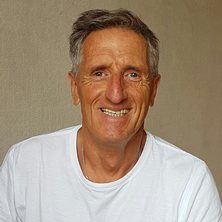
Blog Post by Chris Toal
Added 26-May-2016
More Blog Posts
- Stretch Your Hamstrings, Save Your
- Cold water, healing or harm?
- Personal Training
- Alla Kalinina's one off hand embroidered designs
- Presentation & training at Massage NZ
- Facing up to your emotions!
- Who is going to pay your bills?
- Understanding your intuition
- Understanding our treatment methods
- Stop cooking yourself!
- Bacteria whispering
- Pet massage for our furry friends
- Tinnitus; the bells are ringing!
- The real cost of OOS
- Doing your own 'Haka' for health!
It all starts with 90 minutes that could change your life!
With our exclusive BodyAudit© we both find out what is really wrong with you, so finally you can get started on your journey back to health.
Our Team

Chris Toal
A passionate Forensic Bodyworker for two decades, Chris says that he's only a facilitator of communication between you and your body. He believes that many persistent unresolved injuries and conditions are only waiting for...
more
Alla Kalinina
Alla has a deep base to draw on. A renowned dance choreographer and fitness instructor in her homeland, Ukraine, her Aerobic dance teams were European champions. Alla is also a qualified mobility therapist...
moreLike a free info pack?
We would really love to help. No change No charge!
Provide us with a quick outline of your health issues and we will send you relevant info and references from others that have been where you are and are now well. Stop struggling; this is not living - you are supposed to be clear headed and happy.